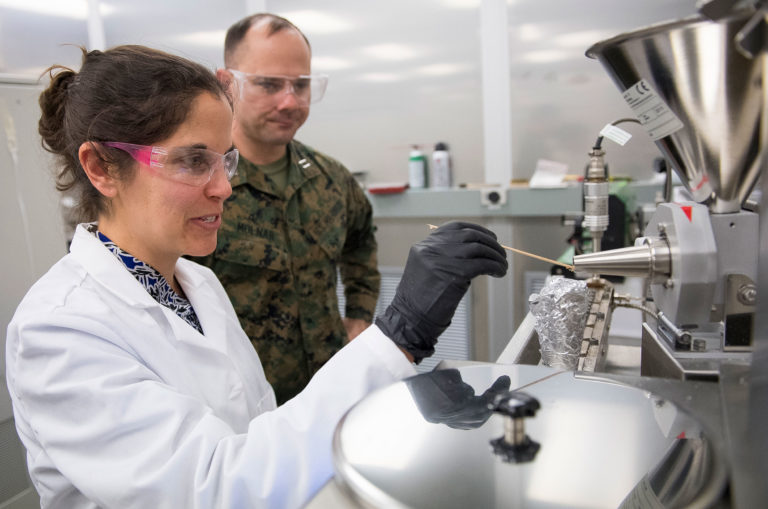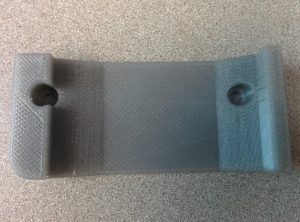The military researchers presented their work this week at the 256th National Meeting & Exposition of the American Chemical Society.
“Ideally, soldiers wouldn’t have to wait for the next supply truck to receive vital equipment,” said Nicole Zander, PhD. “Instead, they could basically go into the cafeteria, gather discarded water bottles, milk jugs, cardboard boxes and other recyclable items, then use those materials as feedstocks for 3D printers to make tools, parts and other gadgets.”
According to the US Government Accountability Office, the Department of Defense has an inventory of 5 million items distributed through eight supply chains in order to keep military personnel supplied with food, fuel, ammunition and spare parts. Few of these items are stockpiled at front-line locations, however, meaning that shortages can occur at critical times. Many of these front-line locations do have 3D printers, but they often have to wait an extended period of time for feedstock to be replenished.

Nicole Zander, ARL, demonstrates equipment for Capt. Anthony Molnar, U.S. Marine Corps. [Image: Jhi Scott/US Army]
Originally, the researchers found that other types of plastic, like polypropylene (PP), which is found in yogurt and cottage cheese containers, and polystyrene (PS), used in plastic utensils, were not practical for 3D printing, but some tinkering made them more useful. They strengthened the PP by mixing it with cardboard, wood fibers and other cellulose waste materials, and they also blended PS with PP to make a strong and flexible filament.
 The team used a process called solid-state shear pulverization to create composite PP/cellulose materials. Shredded plastic and paper, cardboard or wood flour was pulverized in a twin-screw extruder to generate a fine powder, which was then melted and processed into filament. The researchers tested the new composites and discovered that they had improved mechanical properties that could be used to 3D print strong objects.
The team used a process called solid-state shear pulverization to create composite PP/cellulose materials. Shredded plastic and paper, cardboard or wood flour was pulverized in a twin-screw extruder to generate a fine powder, which was then melted and processed into filament. The researchers tested the new composites and discovered that they had improved mechanical properties that could be used to 3D print strong objects.
Zander and her team are building a mobile recycling center that will allow trained soldiers to make 3D printing filaments out of plastic waste. They are also looking into ways to 3D print from plastic pellets instead of filament, which could allow for the printing of larger objects.
“We still have a lot to learn about how to best process these materials and what kinds of additives will improve their properties,” Zander said. “We’re just scratching the surface of what we can ultimately do with these discarded plastics.”
Discuss this and other 3D printing topics at 3DPrintBoard.com or share your thoughts below.
Subscribe to Our Email Newsletter
Stay up-to-date on all the latest news from the 3D printing industry and receive information and offers from third party vendors.
You May Also Like
3D Printing Webinar and Event Roundup: April 7, 2024
Webinars and events in the 3D printing industry are picking back up this week! Sea-Air-Space is coming to Maryland, and SAE International is sponsoring a 3D Systems webinar about 3D...
Roboze Brings Performance Polymer 3D Printing to SoCal via New Partnership
High-performance polymer 3D printing firm Roboze has been steadily working to expand its global footprint, with a firm eye on distributed manufacturing, particularly with regard to the oil and gas,...
3D Printing Webinar and Event Roundup: March 3, 2024
In this week’s roundup, we have a lot of events taking place, including SPE’s ANTEC 2024, Futurebuild, the AAOP Annual Meeting, JEC World, and more. Stratasys continues its training courses,...
Advanced Manufacturing Firm Zeda Acquires The Orthopedic Implant Company
Zeda, the San Francisco-based provider of advanced manufacturing solutions, announced that it has acquired The Orthopedic Implant Company (OIC), a medical device manufacturer based in Reno, Nevada, for an undisclosed...
































